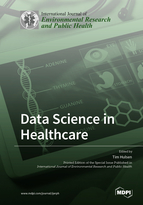Data Science in Healthcare
A special issue of International Journal of Environmental Research and Public Health (ISSN 1660-4601). This special issue belongs to the section "Digital Health".
Deadline for manuscript submissions: closed (31 December 2020) | Viewed by 52995
Special Issue Editor
Interests: bioinformatics; oncology; data science; data management; machine learning; artificial intelligence
Special Issues, Collections and Topics in MDPI journals
Special Issue Information
Dear Colleagues,
Data science is an interdisciplinary field that applies numerous techniques, such as machine learning, neural networks, and deep learning, to create value, based on extracting knowledge and insights from available data. Advances in data science are having a major impact on healthcare. While advances in the sharing of medical information result in better and earlier diagnoses and more patient-tailored treatments, information management is also affected by trends such as increased patient-centricity (with shared decision making), self-care (e.g., using wearables), and integrated care delivery. The way in which health services are delivered is being revolutionized through the sharing and integration of health data across organizational boundaries. Via data science, researchers can deliver new approaches to merge, analyze, and process complex data and gain more actionable insights, understanding, and knowledge at individual and population level. This Special Issue focuses on how data science is used in healthcare (e.g., through predictive modeling) and on related topics such as data sharing and data management.
Dr. Tim Hulsen
Guest Editor
Manuscript Submission Information
Manuscripts should be submitted online at www.mdpi.com by registering and logging in to this website. Once you are registered, click here to go to the submission form. Manuscripts can be submitted until the deadline. All submissions that pass pre-check are peer-reviewed. Accepted papers will be published continuously in the journal (as soon as accepted) and will be listed together on the special issue website. Research articles, review articles as well as short communications are invited. For planned papers, a title and short abstract (about 100 words) can be sent to the Editorial Office for announcement on this website.
Submitted manuscripts should not have been published previously, nor be under consideration for publication elsewhere (except conference proceedings papers). All manuscripts are thoroughly refereed through a single-blind peer-review process. A guide for authors and other relevant information for submission of manuscripts is available on the Instructions for Authors page. International Journal of Environmental Research and Public Health is an international peer-reviewed open access monthly journal published by MDPI.
Please visit the Instructions for Authors page before submitting a manuscript. The Article Processing Charge (APC) for publication in this open access journal is 2500 CHF (Swiss Francs). Submitted papers should be well formatted and use good English. Authors may use MDPI's English editing service prior to publication or during author revisions.
Keywords
- data science
- big data
- healthcare
- medicine
- prediction models
- data sharing
- data management






